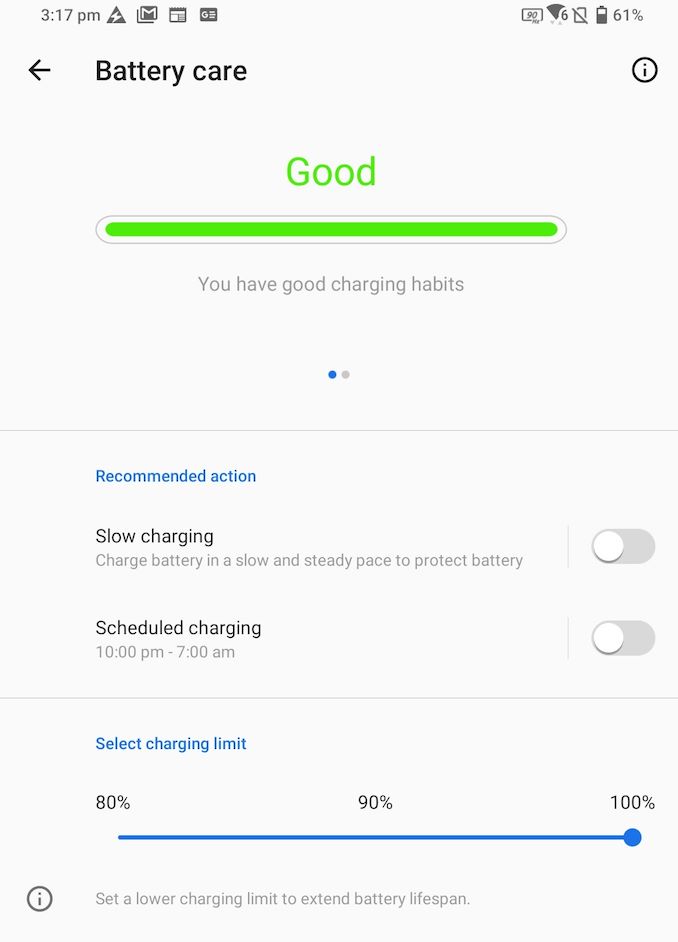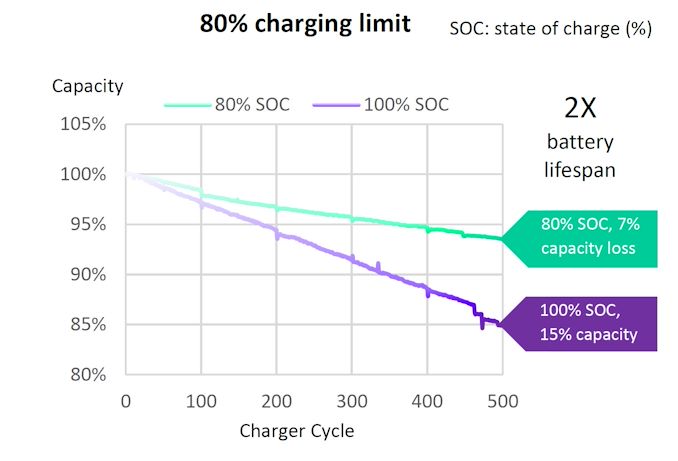The ASUS ZenFone 7 Pro Review: The Triple Flip-Camera
by Andrei Frumusanu on September 1, 2020 3:00 AM EST- Posted in
- Mobile
- Asus
- Smartphones
- ZenFone 7
- ZenFone 7 Pro
Battery Life
The ZenFone 7’s come with a 5000mAh battery which is above-norm compared to other devices on the market. Together with what should be an efficient display and the Snapdragon 865 SoC, we hope the ZenFone 7 Pro to perform quite well in the battery tests.

In the web-browsing test, the phone reached “only” 10.95h when in the 90Hz display mode. I say “only”, as given the phone’s very large battery capacity I had expected a little more out of the device. In fact, it lags behind the S20 Ultra which also houses a 5000mAh battery, but runs its screen at 120Hz.

In PCMark, we likewise see some rather disappointing results. At 60Hz, the phone lasted “only” 10.21h which is far below the expectations of a device with such a larger calibre battery. It’s quite a contrast to the ROG Phone III’s 16.33h runtime even though the devices should fare similarly at this refresh-rate, with an only 17% difference in battery capacity.
Likewise, I’m rerunning the 90Hz battery test to verify some results and issues I ran into.
Overall, the ZenFone 7’s battery life was quite odd and behaving quite below expectations. I’m not sure as to why this is happening. It’s true that the ZenFone is tuned to be more aggressive in performance than the ROG Phone III, but the delta in battery life between the two devices is too great, and comparatively to other 1080p 90Hz S865 devices it also doesn’t do as well. The OnePlus 8 with a 4300mAh battery clearly outpaces the ZenFone 7 without too much trouble.
Battery Health & Care
ASUS had put what I deem to be a quite unusual amount of focus on battery health of the device, and I found this to be a breath of fresh air amongst a crowd of vendors who seemingly just want to one-up themselves with absurd high charging speeds.
Beyond allowing for the option to disable fast-charging altogether from the phone side, and having smart scheduled charging features which allow you for example to only top-off the phone to 100% only in the mornings before you wake up, ASUS goes even further and even allows you to artificially limit the maximum state of charge the phone charges to.
Limiting the maximum state of charge level to 80% instead of 100% for example claims to reduce the battery capacity degradation over time by half. The above graph and data showcase the capacity degradation over charge cycles on the ZenFone 6 with 18W fast-charging.
ASUS deemed all these options and features to be beneficial to the customer and his device over prolonged usage – and the battery on the ZenFone 7 is even specially designed with a thicker anode-cathode separator to allow for faster charging and better capacity retention.
ASUS had put what I deem to be a quite unusual amount of focus on battery health of the device, and I found this to be a breath of fresh air amongst a crowd of vendors who seemingly just want to one-up themselves with absurd high charging speeds.
The phone features 30W USB-PD charging and features a corresponding (PPS compatible) charger in the box by default, however they don’t hide that faster charging does degrade your battery faster.
I’ve never seen a vendor be this transparent and forthright about the negatives of fast-charging and battery degradation in general, and I applaud ASUS for it.












31 Comments
View All Comments
JfromImaginstuff - Tuesday, September 1, 2020 - link
Seriously, doing away with the headphone jack in exchange for 5G. Might as well go with Samsungs.yu - Tuesday, September 1, 2020 - link
Yeah they say 5G antennas are small, sometimes they omit the fact that you need more than a dozen of them.melgross - Tuesday, September 1, 2020 - link
You need from three to five, depending on whether you’re using sub mm bands or not, not dozens.Quantumz0d - Tuesday, September 1, 2020 - link
It's 100% b.s LG V60 and Sony Xperia Mark II both of them are 5G and LG even has full U.S band support with mmWave technology as well and has a superior Audio performance from the standalone RFI shielded high end ESS9219 DAC chipset (ESS9218P was being featured in LG phones from V30 and up) and both of them have IP68 rating along with Qi charging too. The fact that Note 20 gets a full blown Silo for the S-Pen makes so fucking ground for these lying bastards. Removing jack is saving pennies and forcing them to buy accessories which also die out due to the Li-Ion technology.5j3rul3 - Tuesday, September 1, 2020 - link
Can anyone describe how to understand the ∆E ITP and ∆E ITP LC value?I did use ∆E 2000 with Gamma 2.2 for long time, but even searching in google, the data just saying about Rec.2100, EOTF, PQ, HLG and ITU-R....
I knew ∆E ITP is a part of Rec.2100 HDR...but, the info I really want to know is the relationship between ∆E ITP (LC) and real world.
∆E 2000 < 1:Great and almost perfect
∆E 2000 < 2:so hard to see the difference and it's good enough for professional users
∆E 2000 < 3:good for general users
∆E 2000 < 5:ok for general users but still has noticebal color difference
∆E 2000 > 7:esay to see the color difference
Can ∆E ITP and ∆E ITP LC use those standards (0 ~ 1 ~ 2 ~ 3 ~ 5 ~ 7 ~)?
Andrei Frumusanu - Tuesday, September 1, 2020 - link
dE ITP is a new standard that takes into account more modern reproduction formats such as HDR. Generally ITP is a little more sensitive than the 2000 standard to colour deviations: https://kb.portrait.com/help/about-deltae-edE ITP LC as I use it in the new reviews is simply a luminance compensated value, meaning that the error value ignores the luminance error and only looks at hue and chromacity. This makes sense for example in this review here as the ZenFone is targeting a 2.4 gamma by default, however our measurements are against a 2.2 gamma target. So the dE LC values are always going to be lower since it ignoers that part of the colour inaccuracy.
Under dE ITP of 1 it's imperceptible, under 3 it becomes acceptable when not viewed next to each other, and over 10 means it's horribly wrong.
5j3rul3 - Thursday, September 3, 2020 - link
Thank you @Andrei, the reply is really helpful!!!Now I can read the Calman's color calibration charts and info well based on that very useful knowledge, and easy to judge which device can provide great display quality.
Two more things I was wondering in this article:
1. The devices that Anandtech had reviewed such as Mate 20, iPhone XR, Xperia 1 even Surface Pro or XPS13, will get the updated display quality review based on the new delta ITP (LC) standard?
2. ASUS ZenFone 7 Series has a telephoto camera that has very similar spec to HUAWEI and Honor devices' (OV8856, 1/4.4", 1 um, F2.2, 80 mm{, OIS}, with terrible PDAF). It brings 3X Optical Zoom to ASUS smartphone first time and I'm expecting the 3X OZ camera can shows on ZenFone 7 Pro's review. This will be interesting if we have a comparison between ZF7P, 1+7P, M30P, P30 those who having a 3X OZ camera.....is there any opportunity to see this kind of comparison?
in the end, I really thank to AnandTech's great quality reviews!!!
shabby - Tuesday, September 1, 2020 - link
"This is something that ASUS actively acknowledges as being a deliberate design choice so that that they could fit in more components and a larger battery"Did they forget about the headphone jack?
drexnx - Tuesday, September 1, 2020 - link
>made phone huge for more componentsoh yeah we couldn't throw the 3.5mm jack in there, not enough room. The 5 gees, you know, they take up too much space.
Hamm Burger - Tuesday, September 1, 2020 - link
I thought that the unexpectedly low battery life might be because this phone did mm-wave 5G. Bit no: having dug up the specs, the highest 5G frequency band it can handle is 3.3–4.2GHz.